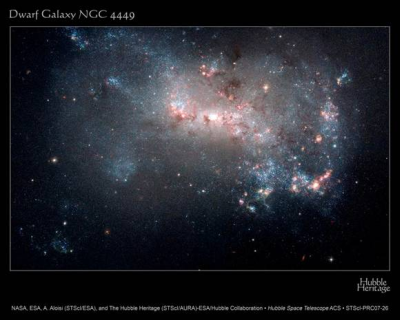19 July 2007

NASA recently published a spectacular image of the dwarf galaxy NGC 4449, acquired by the Hubble Space Telescope (HST). The colorful image shows hundreds of thousands of blue and red stars, resembling a dazzling display of fireworks. NGC 4449 is very near, by cosmic standards. It is "only" about 12.5 million light years away.
Clusters of young bluish-white stars are scattered throughout the galaxy, interspersed with regions of energetic star formation. Huge dark clouds of gas and dust are visible in silhouette against the starlight.
NGC 4449 is believed to be undergoing a burst of star formation. Galaxies showing such a high rate of star formation are termed starburst galaxies. The gas supply that fuels star birth in NGC 4449 is estimated to last roughly a billion years.
Starbursts are usually observed in the central regions of their host galaxies. However, star-forming regions in NGC 4449 are located in the galaxy's core, and in streams surrounding the galaxy. Therefore, NGC 4449 resembles the Universe's earliest galaxies, believed to have grown by merging with and accreting material from smaller stellar systems. The proximity of NGC 4449 makes it an ideal lab for studying the stellar evolution in the early Universe.
Probably, the current starburst within NGC 4449 was the result of a collision or an interaction with a smaller companion galaxy. NGC 4449 is a member of a group of galaxies, located in the direction of the stars of the constellation Canes Venatici, the Hunting Dogs.
The image was taken in November 2005 by an international team of astronomers, led by Alessandro Aloisi of the Space Telescope Science Institute (STScI) and the European Space Agency (ESA).
Further Reading
ESA Press Release
http://www.spacetelescope.org/news/html/heic0711.html
Hubble Heritage Project
http://heritage.stsci.edu/2007/26/
Aymen Mohamed Ibrahem
Senior Astronomy Specialist